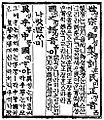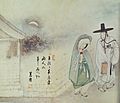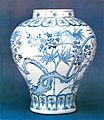Joseon facts for kids
Quick facts for kids
Kingdom of Joseon
조선국 (朝鮮國)
조선왕조 (朝鮮王朝) |
|
|---|---|
| 1392–1897 | |
|
|
|

Territory of Joseon after Jurchen conquest of King Sejong
|
|
| Capital | Hanseong |
| Common languages | Korean |
| Religion | Neo-Confucianism (state religion), Korean Buddhism |
| Government | Monarchy |
| Historical era | Early Modern Period |
|
• Coup of 1388
|
May 20, 1388 |
|
• Coronation of Taejo
|
July 17, 1392 |
| October 9, 1446 | |
|
• Seven-Year War
|
1592–1598 |
| 1636–1637 | |
|
• Treaty of Ganghwa
|
February 27, 1876 |
| October 12, 1897 | |
| Population | |
|
• 1500
|
est. 6,510,000 |
|
• 1753
|
est. 18,660,000 |
| Currency | Mun, Yang |
|
1Became Emperor of Korea in 1897
|
|
The Joseon dynasty (also called Chosŏn or Chosun) was a powerful kingdom in Korea. It lasted for about 500 years, from 1392 to 1897. Yi Seong-gye started the dynasty in July 1392. It replaced the Goryeo kingdom.
The new kingdom moved its capital to what is now Seoul. Joseon expanded its borders to the Amnok and Tuman rivers. This happened after they took control of the Jurchens. Joseon was the last and longest-ruling dynasty in Korea. It was guided by Confucianism.
Contents
Joseon's Culture and Beliefs
During the Joseon period, Chinese Confucian ideas became very important in Korean society. Neo-Confucianism was the official way of thinking for the new dynasty. This meant that Buddhism was not as popular. Sometimes, Buddhists even faced difficulties from the government.
Joseon gained strong control over the land we know as Korea today. This time saw a peak in Korean culture. There was growth in trade, literature, science, and technology.
The Joseon dynasty was known for making Confucianism its main philosophy. However, Buddhism was still part of life in Joseon. Writings between Confucian scholars and Buddhists show that Buddhism was not completely removed. These writings suggest a mix of both philosophies.
Cultural Achievements
The Joseon Dynasty had two big periods of cultural growth. During these times, Joseon culture created the first Korean tea ceremony. They also designed beautiful Korean gardens. Many important historical books were written.
The royal family also built many strong fortresses and grand palaces. The middle to late Joseon period is seen as a golden age for Korean painting.
Challenges and Decline
The Joseon dynasty faced tough times in the late 1500s and early 1600s. The Japanese invasions of Korea (1592–98) and two Manchu invasions (in 1636) almost took over the Korean Peninsula. These wars made Joseon adopt a very strict policy of isolation. Because of this, Westerners called Korea the "hermit kingdom".
After the invasions from Manchuria ended, Joseon had almost 200 years of peace. However, the kingdom's power slowly weakened towards the end of the 1700s. Joseon faced many problems. There were fights for power within the government. There was pressure from other countries. Also, rebellions happened at home. All these issues led to a quick decline of the Joseon dynasty in the late 1800s.
Joseon's Lasting Impact
The Joseon period left a huge mark on modern Korea. Much of today's Korean culture comes from this time. This includes manners, social rules, and how people think about current issues.
The modern Korean language and its different dialects developed during Joseon times. Korea's main ethnic group calls themselves the "Joseon people." This shows how much they connect to the culture and traditions of the Joseon dynasty.
Images for kids
-
King Taejo's portrait
-
Portrait of Ha Yeon, who served as Chief State Councillor during King Sejong's reign
-
Portrait of the neo-Confucian scholar, Jo Gwang-jo (1482–1519)
-
The Turtle ship (replica)
-
A portrait of a civil bureaucrat in the Joseon period
-
Men's (right) and Women's (left) clothes (Hanbok) of Joseon period. A portrait painted by Shin Yun-bok (1758–?).
-
Landscape of Mt. Geumgang by Kim Hong-do (1745–1806) in 1788
-
Korean celestial globe first made by the scientist Jang Yeong-sil during the reign of King Sejong
-
Japanese illustration of King Gojong and Queen Min receiving Inoue Kaoru
-
This compilation photo, taken about 1915, shows the following royal family members, from left: Yi Kang, Prince Imperial Ui, the 6th son of Gojong; Yi Cheok, Emperor Sunjong, the 2nd son and the last monarch of Korea; Yi Un, Prince Imperial Yeong, the 7th son; Gojong, the Retired Emperor; Empress Yun, wife of Sunjong; Lady Kim, Consort Princess Imperial Ui, wife of Prince Imperial Ui; and Yi Geon, the eldest son of Prince Ui. The seated child in the front row is Princess Deokhye, Gojong's 5th daughter and youngest (14th) child. (This is a compilation of individual photographs since the Japanese did not allow them to be in the same room at the same time, and some were forced to leave Korea).
See also
 In Spanish: Dinastía Joseon para niños
In Spanish: Dinastía Joseon para niños






























